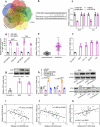Circular RNA_0000326 promotes bladder cancer progression via microRNA-338-3p/ETS Proto-Oncogene 1/phosphoinositide-3 kinase/Akt pathway
- PMID: 34889689
- PMCID: PMC8810167
- DOI: 10.1080/21655979.2021.2008738
Circular RNA_0000326 promotes bladder cancer progression via microRNA-338-3p/ETS Proto-Oncogene 1/phosphoinositide-3 kinase/Akt pathway
Abstract
Circular RNAs (circRNAs) play a pivotal regulatory role in bladder cancer (BC) occurrence and progression. The expression level, role and mechanism of circ_0000326 in BC remain unknown. In the present study, quantitative reverse transcription-polymerase chain reaction (qRT-PCR) was conducted to evaluate the expressions of circ_0000326, microRNA-338-3p (miR-338-3p) and ETS Proto-Oncogene 1(ETS1) mRNA in BC tissues and cell lines. Cell counting kit-8 (CCK-8) assay, wound healing assay and flow cytometry were used to detect the impacts of circ_0000326 on BC cell growth, migration and apoptosis. Western blot was used to detect the expressions of ETS1, phospho-phosphoinositide-3 kinase (p-PI3K), phospho-AKT, PI3K and AKT protein. Gene ontology (GO) analysis and Kyoto Encyclopedia of Genes and Genomes (KEGG) pathway analysis were performed to analyze the biological function of ETS1 in BC. Here, we found that circ_0000326 expression was significantly elevated in BC cell lines and tissues, and circ_0000326 could promote BC cell growth and migration, and inhibit apoptosis. Dual-luciferase reporter gene assay confirmed that circ_0000326 and ETS1 could bind directly to miR-338-3p. Furthermore, circ_0000326 sponged miR-338-3p and up-regulated ETS1 expression. ETS1 was associated with the activation of PI3K/AKT pathway. Moreover, circ_0000326 could activate PI3K/AKT pathway by miR-338-3p/ETS1 axis. Collectively, circ_0000326/miR-338-3p/ETS1/PI3K/AKT pathway is involved in regulating BC progression.
Keywords: Circ_0000326; ETS1; PI3K/AKT; bladder cancer; miR-338-3p.
Conflict of interest statement
No potential conflict of interest was reported by the author(s).
Figures






Similar articles
-
Circular RNA circ_0006089 promotes the progression of gastric cancer by regulating the miR-143-3p/PTBP3 axis and PI3K/AKT signaling pathway.J Dig Dis. 2022 Jul;23(7):376-387. doi: 10.1111/1751-2980.13116. Epub 2022 Aug 23. J Dig Dis. 2022. PMID: 35844201
-
Hsa_circ_CSPP1/MiR-361-5p/ITGB1 Regulates Proliferation and Migration of Cervical Cancer (CC) by Modulating the PI3K-Akt Signaling Pathway.Reprod Sci. 2020 Jan;27(1):132-144. doi: 10.1007/s43032-019-00008-5. Epub 2020 Jan 1. Reprod Sci. 2020. PMID: 32046405
-
MicroRNA-338-3p inhibits the progression of bladder cancer through regulating ETS1 expression.Eur Rev Med Pharmacol Sci. 2019 Mar;23(5):1986-1995. doi: 10.26355/eurrev_201903_17237. Eur Rev Med Pharmacol Sci. 2019. PMID: 30915741
-
Crosstalk between circRNAs and the PI3K/AKT signaling pathway in cancer progression.Signal Transduct Target Ther. 2021 Nov 24;6(1):400. doi: 10.1038/s41392-021-00788-w. Signal Transduct Target Ther. 2021. PMID: 34815385 Free PMC article. Review.
-
Exploring the dual role of circRNA and PI3K/AKT pathway in tumors of the digestive system.Biomed Pharmacother. 2023 Dec;168:115694. doi: 10.1016/j.biopha.2023.115694. Epub 2023 Oct 11. Biomed Pharmacother. 2023. PMID: 37832407 Review.
Cited by
-
MTBP enhances the activation of transcription factor ETS-1 and promotes the proliferation of hepatocellular carcinoma cells.Front Oncol. 2022 Aug 29;12:985082. doi: 10.3389/fonc.2022.985082. eCollection 2022. Front Oncol. 2022. PMID: 36106099 Free PMC article.
-
Circ_0000758 Facilitates Bladder Cancer Cell Growth, Migration and Angiogenesis Via Severing as miR-1236-3p Sponge.Biochem Genet. 2024 Jun 13. doi: 10.1007/s10528-024-10855-w. Online ahead of print. Biochem Genet. 2024. PMID: 38869664
-
The implications for urological malignancies of non-coding RNAs in the the tumor microenvironment.Comput Struct Biotechnol J. 2023 Dec 20;23:491-505. doi: 10.1016/j.csbj.2023.12.016. eCollection 2024 Dec. Comput Struct Biotechnol J. 2023. PMID: 38249783 Free PMC article. Review.
-
Melatonin Protects Against Hyperoxia-Induced Apoptosis in Alveolar Epithelial type II Cells by Activating the MT2/PI3K/AKT/ETS1 Signaling Pathway.Lung. 2023 Apr;201(2):225-234. doi: 10.1007/s00408-023-00610-0. Epub 2023 Mar 17. Lung. 2023. PMID: 36928143
-
Identification of a dysregulated CircRNA-associated gene signature for predicting prognosis, immune landscape, and drug candidates in bladder cancer.Front Oncol. 2022 Oct 10;12:1018285. doi: 10.3389/fonc.2022.1018285. eCollection 2022. Front Oncol. 2022. PMID: 36300085 Free PMC article.
References
MeSH terms
Substances
Grants and funding
LinkOut - more resources
Full Text Sources
Other Literature Sources
Medical
Miscellaneous
